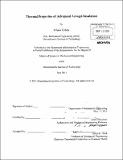Thermal properties of advanced aerogel insulation
Author(s)
Cohen, Ellann
DownloadFull printable version (9.900Mb)
Other Contributors
Massachusetts Institute of Technology. Dept. of Mechanical Engineering.
Advisor
Leon Glicksman.
Terms of use
Metadata
Show full item recordAbstract
Buildings consume too much energy. For example, 16.6% of all the energy used in the United States goes towards just the heating and cooling of buildings. Many governments, organizations, and companies are setting very ambitious goals to reduce their energy use over the next few years. Because the time periods for these goals are much less than the average lifetime of a building, existing buildings will need to be retrofitted. There are two different types of retrofitting: shallow and deep. Shallow retrofits involve the quickest and least expensive improvements often including reducing infiltration around windows, under doors, etc and blowing more insulation into the attic. Deep retrofits are those that involve costly renovation and typically include adding insulation to the walls and replacing windows. A new, easily installable, inexpensive, and thin insulation would move insulating the walls from the deep retrofit category to the shallow retrofit category and thus would revolutionize the process of retrofitting homes to make them more energy efficient. This thesis provides an overview of a concept for a new, easily installable, inexpensive, thin aerogel-based insulation and goes into detail on how the thermal properties of the aerogel were measured and validated. The transient hot-wire method for measuring the thermal conductivity of very low thermal conductivity silica aerogel (1 0mW/m K at 1 atm) along with a correction for end effects was validated with the NIST (National Institute of Standards and Technology) Standard Reference Material 1459, fumed silica board to within 1 mW/mK. Despite the translucence of the aerogel at certain wavelengths, radiation is not an issue through the aerogel during the hot-wire test but may be an issue in actual use as an insulation. The monolithic aerogel thermal conductivity drops significantly with slightly reduced pressure (3.2 mW/m K at 0.1atm). For the final composite insulation, the new silica aerogel formula is a great choice and it is recommended to reduce the pressure around the aerogel to 1 / 1 0 th. In the future, a prototype of an insulation panel combining a 3-D truss structure, monolithic or granular silica aerogel, and reduced pressure will be constructed and tested.
Description
Thesis (S.M.)--Massachusetts Institute of Technology, Dept. of Mechanical Engineering, 2011. Cataloged from PDF version of thesis. Includes bibliographical references (p. 74-76).
Date issued
2011Department
Massachusetts Institute of Technology. Department of Mechanical EngineeringPublisher
Massachusetts Institute of Technology
Keywords
Mechanical Engineering.